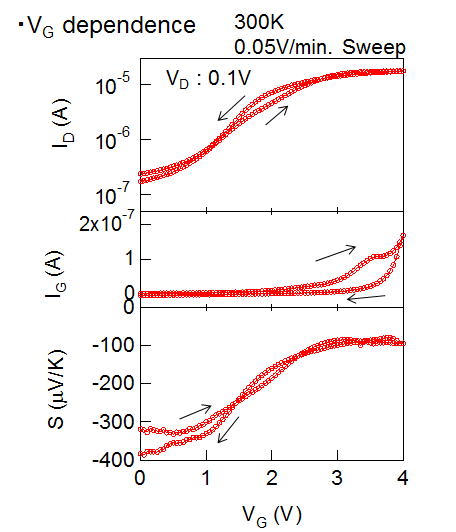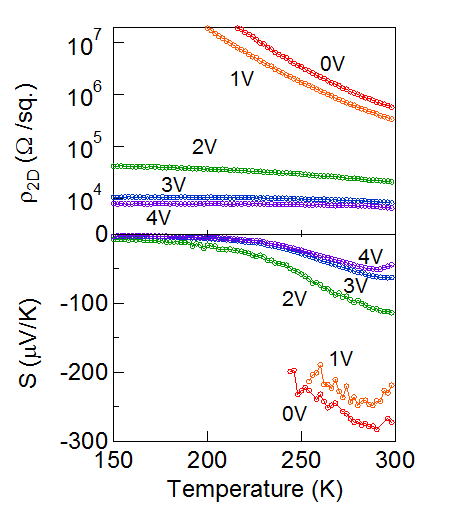Research
Control of the thermoelectric property of ZnO by using electric double layer
Thermoelectric material is required to have large thermopower S, low resistivity ρ, and low thermal conductance κ, since the thermoelectric conversion efficiency is characterized by the figure of merit Z=S2/ρκ. It is, however, difficult to control these physical quantities
independently since they are functions of carrier concentration. At optimum
carrier concentration, large effective mass m* which increases S, and large
mobility μ which decreases ρ are required to improve Z. Recently,
it has been reported that a two-dimensional electron gas (2DEG) in MgZnO
/ ZnO heterointerface shows large m* and μ[1]. So, the 2DEG in ZnO interface
is attractive for thermoelectric material.
Here, we use electric double layer transistor (EDLT) to realize 2DEG on ZnO surface[2]. EDLT is a field effect transistor whose insulating layer is replaced with polymer electrolytes, and can accumulate carrier up to1015 cm-2, which is higher than conventional FETs. Moreover, compared to chemical doping, we can expect further improvement of Z by reducing impurity scattering.
ZnO polycrystalline sample was used to measure ρ and S with EDLT configuration. ρ was measured using a two-probe method and the S was measured using a steady-state technique. A temperature gradient of about 1 K/cm was applied to the sample, and was monitored by a differential thermocouple. The wired specimen and a Pt gate electrode were immersed in a polymer electrolyte of KClO4/Polyethylene oxide.
As seen in Fig.1 and 2, ρ was decreased with increasing gate voltage (GV), and Metal-insulator transition (MIT) occurred between GV=2V and 3V, which confirms the carrier doping by FET effect. It has been reported that 2DEG in SrTiO3 enhances S with decreasing 2DEG thickness[3]. However the enhancement of S was not observed with increasing GV (Increase of GV decrease 2DEG thickness). 2DEG thickness was estimated about 10 nm by using sheet carrier density (estimated from Hall coefficient) and the critical carrier density of MIT in ZnO. We considered that 2DEG thickness was not thin enough to enhance S (~ 1.5 nm). On the other hand, the power factor of 2DEG is estimated as 10-3Wm-1K-2 at 300K. This value is smaller than that obtained in chemical doping[4,5]. However, we consider that the thermoelectric properties are enhanced by controlling carrier by using EDLT.

Fig.1:GV dependence of ID, IG, and thermopower.

Fig. 2: Temperature dependence of sheet resistivity and thermopower.
[1]A. Tsukazaki, st al., Nat. Matr. 9, 889 (2010)
[2]K. Ueno, et al., Nat. Matr. 7, 855 (2008)
[3]H. Ohta, et al., Nat. Matr. 6, 129 (2007)
[4]M.Ohtaki et al., J. Electron. Mater. 38, 1234 (2009)
[5]D. Berarden et al., J. Am. Ceram. Soc. 93, 2352 (2010)
Here, we use electric double layer transistor (EDLT) to realize 2DEG on ZnO surface[2]. EDLT is a field effect transistor whose insulating layer is replaced with polymer electrolytes, and can accumulate carrier up to1015 cm-2, which is higher than conventional FETs. Moreover, compared to chemical doping, we can expect further improvement of Z by reducing impurity scattering.
ZnO polycrystalline sample was used to measure ρ and S with EDLT configuration. ρ was measured using a two-probe method and the S was measured using a steady-state technique. A temperature gradient of about 1 K/cm was applied to the sample, and was monitored by a differential thermocouple. The wired specimen and a Pt gate electrode were immersed in a polymer electrolyte of KClO4/Polyethylene oxide.
As seen in Fig.1 and 2, ρ was decreased with increasing gate voltage (GV), and Metal-insulator transition (MIT) occurred between GV=2V and 3V, which confirms the carrier doping by FET effect. It has been reported that 2DEG in SrTiO3 enhances S with decreasing 2DEG thickness[3]. However the enhancement of S was not observed with increasing GV (Increase of GV decrease 2DEG thickness). 2DEG thickness was estimated about 10 nm by using sheet carrier density (estimated from Hall coefficient) and the critical carrier density of MIT in ZnO. We considered that 2DEG thickness was not thin enough to enhance S (~ 1.5 nm). On the other hand, the power factor of 2DEG is estimated as 10-3Wm-1K-2 at 300K. This value is smaller than that obtained in chemical doping[4,5]. However, we consider that the thermoelectric properties are enhanced by controlling carrier by using EDLT.

Fig.1:GV dependence of ID, IG, and thermopower.

Fig. 2: Temperature dependence of sheet resistivity and thermopower.
[1]A. Tsukazaki, st al., Nat. Matr. 9, 889 (2010)
[2]K. Ueno, et al., Nat. Matr. 7, 855 (2008)
[3]H. Ohta, et al., Nat. Matr. 6, 129 (2007)
[4]M.Ohtaki et al., J. Electron. Mater. 38, 1234 (2009)
[5]D. Berarden et al., J. Am. Ceram. Soc. 93, 2352 (2010)
